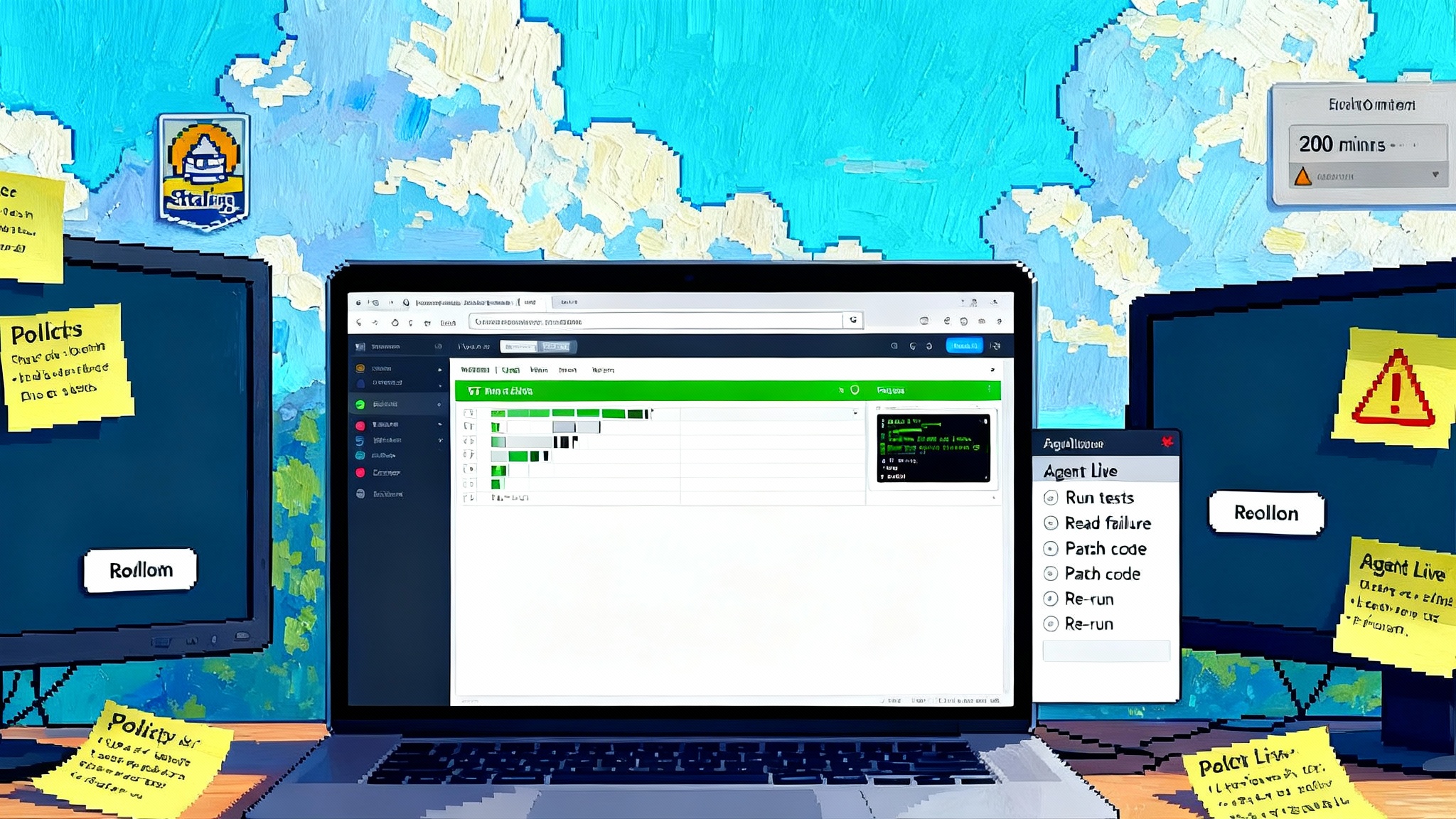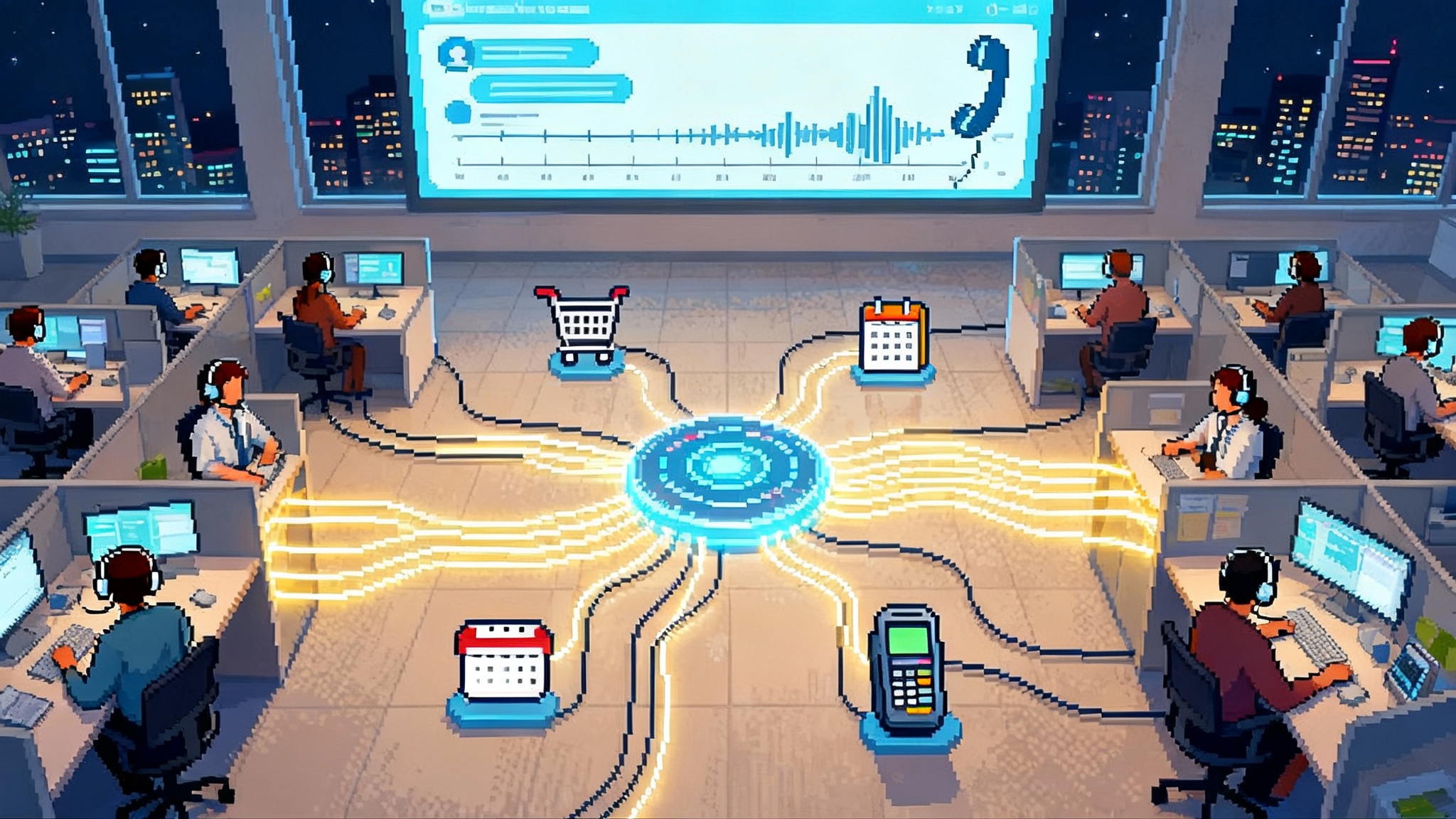Replit Agent 3 makes autonomous, self-healing coding real
Replit Agent 3 shifts AI coding from assistive to autonomous with a browser-native test and fix loop, long-run sessions, and practical guardrails. See how to adopt it safely and why it will reshape backlogs and budgets.

The week autonomous coding stopped being a demo
On September 10, 2025, Replit shipped Agent 3 and quietly moved software agents from assistive pair programmers to autonomous builders that test, fix, and repeat until the work is done. The headline features are blunt and practical. A browser-based test and fix loop that runs code where it will actually execute. Long autonomous sessions lasting up to 200 minutes so an agent can take on whole jobs instead of half steps. Agent-generation and automations so one agent can spin up another with the right skills and guardrails baked in. In other words, a path from point solutions to a production system.
If you have tried earlier agent tools, you know the pattern. They suggest edits, you apply them, they forget context, you explain again, and the cycle drags on. Agent 3 changes the center of gravity. It treats the browser as a stable workbench, keeps the code, tests, and logs in one place, and drives a disciplined loop. Write. Run tests. Read failures. Patch. Re-run. That rhythm is mundane, which is exactly why it works.
From assistive to autonomous
The best way to see the shift is to track responsibility. Assistive agents were narrow. They drafted a function, wrote a test, or summarized an error. You held the steering wheel. Agent 3 aims for task-level outcomes. It can be told to add passwordless login, migrate a database column, or refactor an integration that breaks on every minor release. The 200-minute window is important here. Many meaningful software tasks simply do not fit inside a short loop. A task needs time to set up a feature branch, run a full test suite, hit a staging environment, fix flaky tests, and clean up artifacts. Giving an agent a long, contained runway lets it finish the lap.
Self-testing and self-healing are the second hinge. Self-testing means the agent does not guess whether something works. It runs tests in the same place it edits code, captures output, and interprets the result. Self-healing means it treats failed tests as guidance rather than a dead end. It turns a red test into a to-do list and keeps going until the tests are green or the time budget runs out.
Agent-generation and automations make that loop scale. An agent can create a new specialized agent with a template of permissions, libraries, and playbooks. Automations chain repeatable activities like nightly dependency updates, weekly security scans, or per-commit performance checks. Instead of one generalist doing everything, you get a crew of small, focused agents that hand off cleanly.
Why the browser matters more than it sounds
Early agent systems often drove a remote desktop or a headless operating system with simulated clicks and keystrokes. That approach is flexible, but it is brittle and slow. Think of a robot arm trying to cook by moving a mouse. It can work, but one pop-up or a shifted button and the arm is lost.
By keeping the loop inside a browser workspace, Agent 3 reduces the moving parts. File edits, test runs, and logs live in one environment. There is less overhead than routing every step through a remote computer control layer. This shows up as speed and cost. Less orchestration means fewer network round trips. Direct access to files and processes means fewer tokens spent describing the world the agent already has. Since the same environment runs the tests, fewer surprises slip through.
There is also a psychological effect. Developers trust what they can see. Watching an agent write code, run the test suite, and surface the exact console output builds confidence. When it fails, the failure is concrete and local. That makes it easier to adopt these tools for real work rather than toy demos. If you want to see how the browser is becoming the agent’s cockpit across categories, the story of agentic browsers shift power is a helpful parallel.
Claimed speed and cost versus computer-use agents
Computer-use agents control a whole computer. They open windows, move the cursor, and type into forms. That is powerful, but it carries heavy overhead and latency. They often pay for long screen sessions, spend tokens describing visual state, and burn time waiting for applications to load. Even simple tasks can balloon when every action is a narrated click.
Agent 3 flips the model. Instead of narrating clicks, it operates on code and tests directly. Imagine a common ticket. Update an authentication library, fix breaking changes, and update the tests. A computer-use agent might open an editor, navigate menus, edit files, run commands, and handle pop-ups. Each step adds delay and token cost. An in-browser agent can change files, run a test script, parse the log, and patch the failing path in a few cycles. The control surface is text and process output rather than pixels and pointers.
You will still pay for model tokens and compute minutes, but the mix changes. You buy more time in tests and less in narration. That tends to be faster and cheaper when the work is code centric. It also tends to be more predictable, which helps with budgeting. Teams can plan around a 200-minute maximum per run and a known set of automations rather than leaving a desktop session open and hoping nothing stalls.
Reliability is not a footnote
Autonomy without reliability is chaos. The industry has seen its share of rogue-agent incidents. Agents that looped and opened hundreds of tabs. Agents that refactored a system and deleted an uncommitted migration. Agents that tried to fix a flaky test by skipping it everywhere. None of these failures are exotic. They are what you get when you combine broad permissions, long loops, and ambiguous goals.
Agent 3’s framing forces the hard question. What makes a self-healing agent stop and ask for help, and how do you keep it from making a local problem global? The right answer is not a slogan. It is a set of guardrails you can check and enforce.
Four pragmatic guardrails that actually work
- Sandboxing by default
Put every agent in a constrained workspace that mirrors production but cannot hurt it. That means ephemeral environments, restricted network access, and no direct credentials for live systems. The agent should be able to run integration tests against a staging clone and nothing more.
Practical setup: Use per-branch environments seeded from production data snapshots that are already anonymized. Give each agent a role with read-only access to registries and write access only to its workspace. Make secrets short lived, tied to the run, and revoked automatically when the run ends.
- Rollback by default
Every change the agent makes should generate an isolated change set with a revert plan. If the agent opens a pull request, it must include rollback commands. If it migrates data, it must generate a reverse migration that is tested during the run. If it touches configuration, it must write a before and after manifest.
Practical setup: Enforce a policy that no agent-created pull request can be merged without a tested revert step. Make this a check in the pipeline, not a guideline in a handbook. Store artifacts from the run so a human can audit what happened when things go sideways.
- Policy and rules that are explicit and narrow
Agents need rules that are as clear as a firewall. The policy should say what types of files the agent can change, what directories it can touch, which tests count as authoritative, and which tasks require human approval. The policy should also say what the agent must never do, like force push to main or disable a failing test without opening an issue.
Practical setup: Encode the policy in a machine-readable file in the repo. Include allowlists for directories and commands, blocked patterns, and required reviews. Make the agent read and summarize the policy at the start of every run.
- Live monitors that see more than logs
Do not wait for a failure to bubble up in a log. Watch the run in real time. Track CPU spikes that signal a loop, sudden bursts of file writes, or network calls that hit forbidden domains. Expose a pause and stop control. Alert when a run deviates from a known pattern, like running the same test more than a threshold or editing files outside the allowlist.
Practical setup: Add a lightweight telemetry agent alongside the coding agent. It emits a heartbeat with the current step, open files, and last test result. Feed this into a dashboard with rules that flag suspicious behavior. Give humans an intervention button that snapshots the state and stops the run.
A 30, 60, 90 day adoption playbook
You do not have to adopt Agent 3 all at once. A staged rollout builds trust and shows value quickly.
Days 1 to 30: Scope and simulate
- Pick two low-risk maintenance tasks. Dependency updates and flaky test fixes are perfect.
- Write a policy file with clear allowlists and blocked actions. Keep it short and strict.
- Run agents in sandboxes only. No real credentials. Require human approval for every change.
- Measure success by time saved and repeatability. If a human had to step in, record why.
Days 31 to 60: Expand and automate
- Add two feature-level tasks that require touching multiple modules.
- Turn successful runs into automations that trigger on a schedule or a pull request label.
- Introduce rollback checks in the pipeline and require them on every agent change.
- Start building agent templates for common jobs. For example, a test-fixer template and a docs-updater template.
Days 61 to 90: Integrate and monitor
- Allow limited merges to staging branches with automatic reverts on failure.
- Wire telemetry into your observability stack. Alert on loops, drift from policy, and unusual edit patterns.
- Establish a weekly review where your team inspects agent-generated changes. Keep a running list of rule updates.
- Measure value in production terms. Defects avoided, cycle time reduced, and on-call hours reclaimed.
What this means for startups and small and medium enterprises
Application development
- Faster feature delivery with fewer handoffs. A single 200-minute run can complete a scoped feature with tests and documentation. That compresses queues and reduces context switching.
- A new shape of backlogs. Tickets become agent-first. You will write work as goals with policies rather than step lists for humans.
- More consistent quality. Self-testing enforces a contract. If tests are missing, the agent will fail and tell you exactly where the gaps are. That pressure nudges teams to improve coverage and invest in clear test naming.
Quality assurance
- Agents will own more of the flaky test problem. Expect nightly self-heal runs that isolate flaky cases, quarantine brittle assertions, and propose fixes with evidence.
- Exploratory testing will move up the stack. Humans will focus on cross-feature behavior and edge cases that are not easy to encode. The number of repetitive test cycles done by humans will shrink.
- Test writing changes. People will write specimen-rich tests that act as living documentation. Agents will fill in boilerplate and keep tests synchronized with code changes.
Platform economics
- Smaller teams will get platform-grade workflows. Agent-generation and automations let a five-person startup act like a twenty-person team with a tidy release train, regular dependency updates, and documented changes. The way AP goes autonomous at Ramp shows operational leverage is a good analog.
- Budgets will track runs, not seats. The 200-minute cap makes planning concrete. Finance teams can project spend by counting expected runs and the complexity of tasks rather than guessing human hours.
- Clouds will compete on agent ergonomics. The best platform will be the one that offers clean sandboxes, fast test runners, and first-class policy support. Compute price will matter, but smoother agent loops will matter more because they cut rework.
Hiring and roles
- Junior developer roles will tilt toward supervision and policy writing. New hires will spend more time curating tasks and teaching agents how the system should behave.
- Senior engineers will spend more time on interfaces and tests. Contracts between components and clear test catalogs will become the leverage points that let agents work safely.
- A new role will emerge around agent operations. Think site reliability engineering, but for autonomous code runs. The job is to keep loops efficient, healthy, and safe.
Vendor mix and lock-in
- Expect a two-layer stack. Teams will use a model provider and an orchestration platform that delivers the test and fix loop. Swapping models will be easier than swapping the loop, so choose the loop provider with care.
- Open source will matter as a pressure valve. When a platform’s policies or pricing feel tight, teams will look for open agent runners that can execute similar loops on private infrastructure. The portability of policies and automations will become a selling point.
Compliance and risk
- Auditors will ask for agent policies, run logs, and rollback evidence. Treat these as first class artifacts. If you can show a clear policy, a run record, and a tested revert path, reviews will be smoother.
- Data boundaries must be explicit. Make it obvious which datasets an agent can read and which they cannot. Expect questions about prompts that might contain sensitive data. The safest answer is to avoid sensitive data entirely in prompts and use structured inputs instead.
How Agent 3 fits the broader agent trend
We are watching autonomy spread across functions. Customer experience teams are adopting production-grade loops as seen when agentic AI makes CX a beachhead. Analytics is moving the same direction with pipelines that plan, test, and ship, echoing the shape of agentic analytics on the semantic layer. Agent 3 slots into this trend for engineering. The binding idea is the same across domains. Give the agent a stable workspace, a testable objective, and the time and rules to close the loop.
Practical playbook for your first real task
Choose a task that matters but will not wake up your incident channel if something goes wrong. A library upgrade with breaking changes in tests is ideal. Here is a simple flow you can adapt.
- Frame the objective. Describe the goal and the boundaries in one paragraph. Example: upgrade the authentication library to version X, adjust code for API changes, update tests, and keep all security checks green.
- Pin the constraints. Allow the agent to touch only the auth module, its tests, and the integration test directory. Block writes to any production configuration.Require a human approval for any change to the login view.
- Create the sandbox. Snapshot production data with sensitive fields anonymized. Build a per-branch environment with temporary credentials that expire at run end.
- Start with tests. Ask the agent to run the full test suite and label failures by category. If there are flaky tests, have the agent isolate them and propose stabilizations with evidence.
- Upgrade and run. Let the agent perform the upgrade and run tests again. Require it to produce a clear diff of files changed and a list of commands executed.
- Self-heal loop. Allow three cycles of fix and re-test before the agent must ask for help. If it reaches the limit, have it open an issue with full logs and a summary of attempts.
- Prepare rollback. Enforce a reverse migration and a revert script. Verify both during the run.
- Human review. You approve the pull request only after the rollback check passes and the agent has documented the change.
This is not glamorous, but it is how you turn a one-off demo into a habit that saves real time.
Metrics that matter
Measure outcomes that map to business and reliability, not just token counts.
- Cycle time per task. Track the time from ticket start to merged change. Compare human-only tasks to agent-led tasks.
- Stability of tests. Count flaky tests quarantined or fixed per week. Watch whether the flake rate drops and stays down.
- Rollback frequency and success. Measure how often rollbacks are needed and whether they work cleanly. A clean rollback is a sign your guardrails are doing their job.
- Defects avoided. Use pre-production catches as a leading indicator. If the agent catches failures in the sandbox that never reach staging, you are compounding quality.
- Budget predictability. Track variance between planned runs and actual runs. Lower variance means better planning and fewer surprises.
Common objections, answered
- Will the agent make a mess if it gets stuck? Not if you sandbox correctly and monitor live signals. The guardrails section above is the blueprint for containing mistakes.
- Is 200 minutes really enough? It is enough for many task-level jobs if you state the goal and boundaries clearly. If not, split the objective into milestones with artifacts between runs.
- What if our tests are weak? Then the agent will fail fast, which is the right outcome. Use those failures to harden tests. A few weeks of investment here pays off quickly.
- Will we lose control of our codebase? You will gain clarity if you require policy files, change manifests, and rollback scripts. The agent’s discipline becomes your documentation trail.
What to watch in the next quarter
- Real-world case studies that publish time saved, defects avoided, and rollback frequency. Numbers beat anecdotes.
- Templates that spread. When teams share agent templates for common jobs like framework upgrades, adoption accelerates.
- Tooling that enriches the loop. Expect better test flake detectors, policy linters, and dashboards that show what the agent is trying to do in plain language.
The takeaway
Agent 3 is not magic. It is a tighter loop that puts code, tests, and logs in one place and gives the agent time to finish. The long run window unlocks whole tasks. The browser workspace reduces friction and cost. The agent-generation and automations features let you scale successes without reinventing the wheel. The risks are real, but they are tractable with sandboxes, rollbacks, clear rules, and live monitors.
If you run a startup or a small and medium enterprise, the move to autonomous loops is the practical moment you have been waiting for. You do not need to bet the company. Start small, measure aggressively, and automate the wins. In a year, your backlog will read differently, your tests will be sharper, and your platform budget will map to runs instead of meetings. That is what mainstream autonomy looks like in software. It is not a leap of faith. It is a new habit that compounds.








